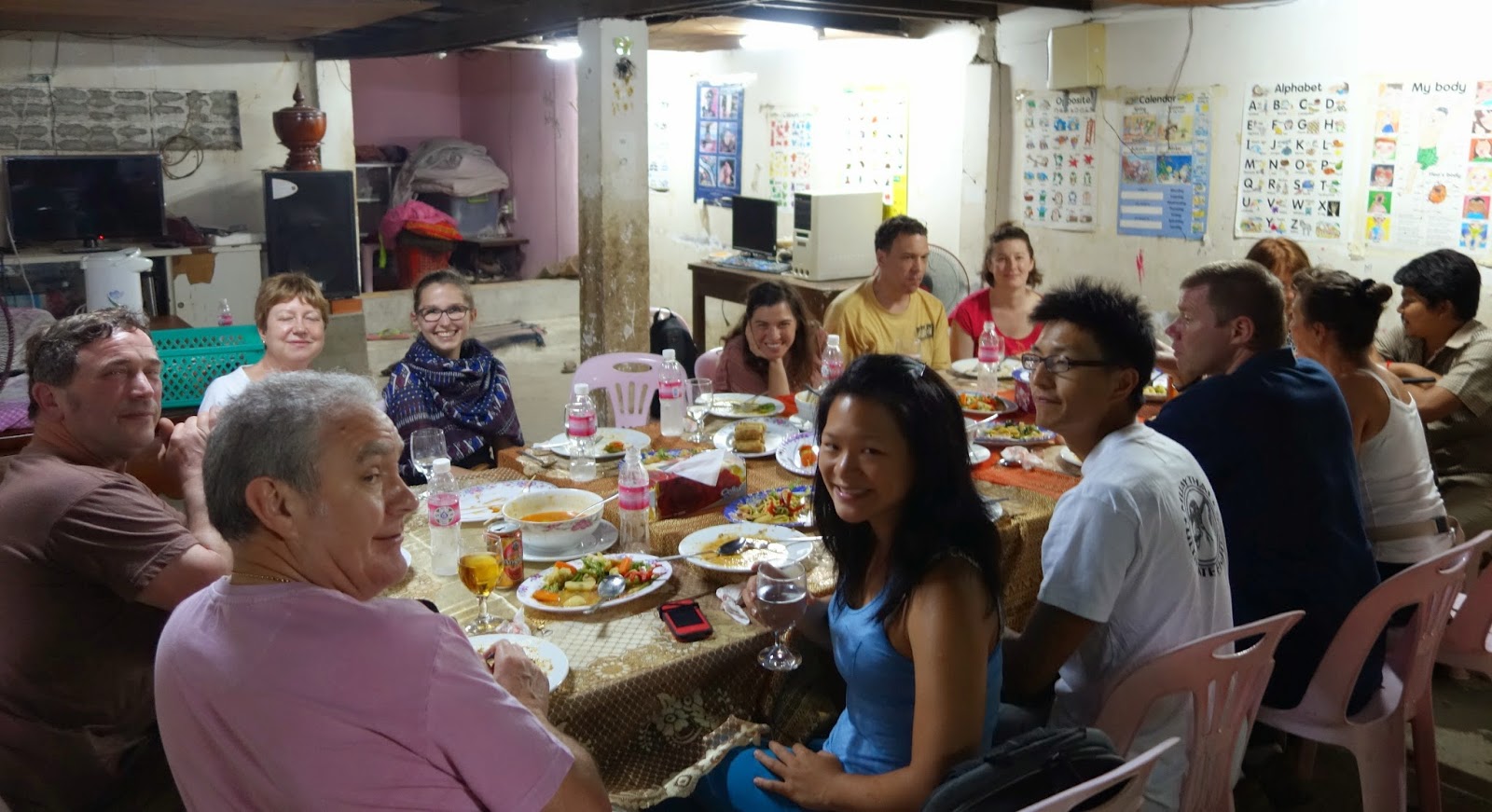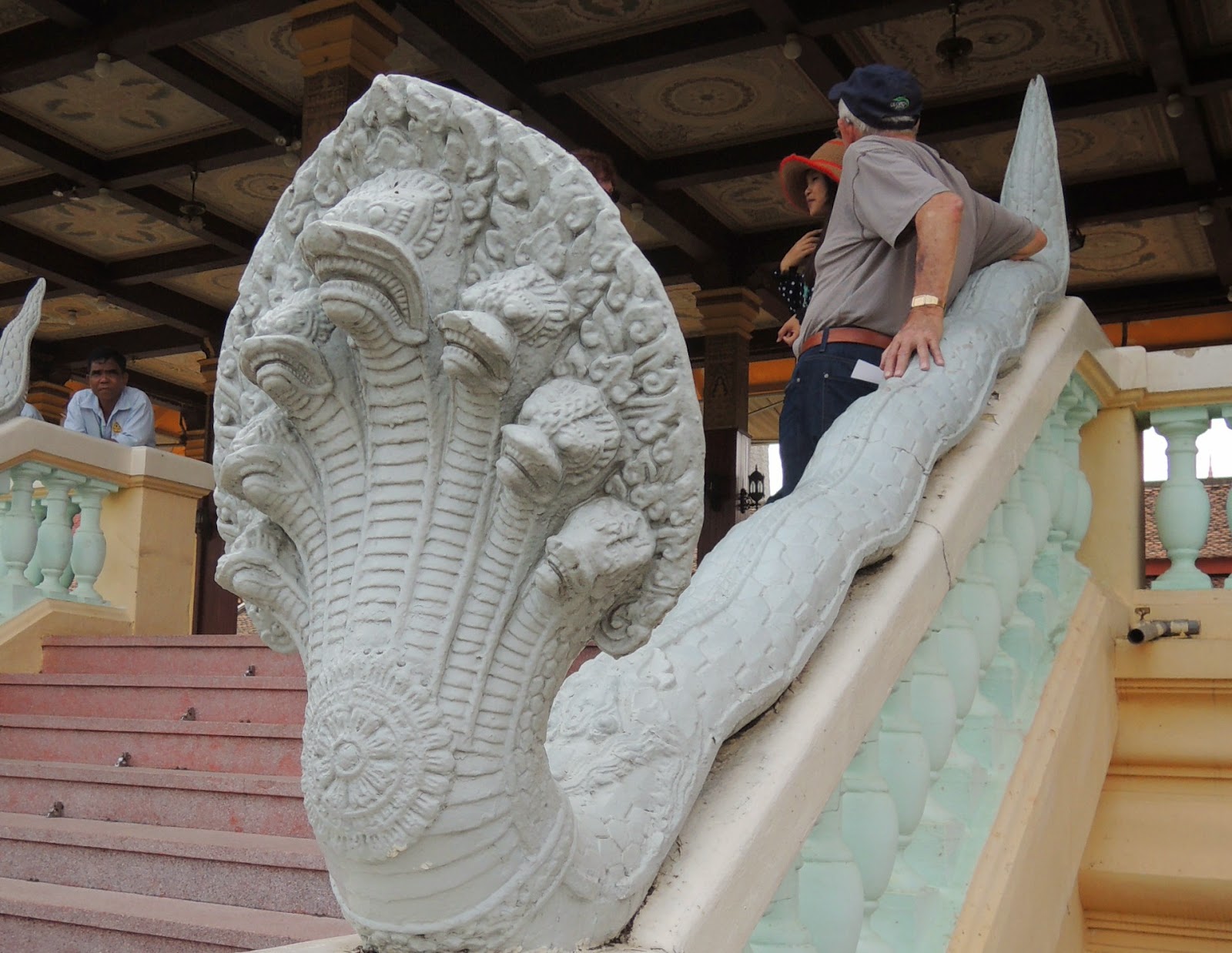Phnom Penh is the capital and largest city of Cambodia, with about 2.5 million people. Once called the Pear of Asia, it was a very beautiful city. Our tour followed the Mekong in many places and Phnom Penh is on the Mekong. The Mekong starts in china and flows through Miyamar (Burma), Laos, Thailand, Cambodia, and Vietnam before it empties into the S. China Sea. It is the 8th longest river in the world.
We went on Highway 6 from Angkor Wat to Phnom Penh, a road in disrepair that was being "rebuilt" as we drove on it. The road got a bit better as we got close to Phnom Penh, but was not wide and it was slow going.
 |
| Although helmets are required when on a motorcycle, only some wore them |
We stayed at the Diamond Hotel, which was located really close to the Central Market and the central part of town.
Some time during the stay we walked two blocks to the Central Market, an art decco building with many many things for sale. The inside had been remodeled and upgraded in recent years. There was a lot of jewelry for sale in the central area, then lots of clothes, household items, and food in the surround area.
 |
| Love this fruit but cannot remember its name in English, Spanish, or Hebrew |
 |
| Outside of the same fruit |
The first night we had the option of going to a home in Phnom Penh for a home-cooked dinner. One of Kakada's friends who is also a guide has a contact with a family who supplements its income by catering meals in its home. It was a chance for us to visit a home of a family in the city.
The three story home originally belonged to the parents, but they have since died and 5 siblings and their families live in the home. The home, on a dead end street, was about a 20 minutes tuk tuk ride from our hotel. People socializing in the street and in front of the home, sitting outside.
The kitchen is outside the main home, and the end of the dead end. It is covered like a car port so that it can be used in the rainy season.
 |
| Cooking area |
 |
| Cooking storage area |
The inside of the house was mainly the sleeping area and the bathroom. Mats were rolled up and a big table was placed inside for us to sit at to eat.
 |
| Fixed bed behind the table where we ate |
This room used to be used as a place to teach basic English to the neighbors for free. Posters were still on the wall from when such classes were taught.
We met family members including two daughters who were students:
The food they made was delicious. Two of us ate vegetarian. There were several meat dishes for the others but not a lot of meat in any dish except for the skewers, chicken I believe.
 |
| Spring Rolls |
 |
| Delicious vegetarian curry |
 |
| Tofu and veggie Skewers--too much tofu for me |
 |
| Noodle dish |
 |
| Veggie dish, yum |
 |
| Fruit for dessert |
Not sure, but I think we paid $10 or less for the dinner including the tuk tuk ride.
Breakfast was a buffet. We could get omelettes made to order, noodle soup (what Cambodians and other SE Asians ate), fruit, stir fry veggies, fried rice, tapioca noodles, white bread, sausage, potatoes, and other similar European breakfast food.
We had the morning free, so several of us walked to the Royal Palace which was constructed in the 1860s for the king of Cambodia.
Along the way were some interesting sites.
 |
| A cycle driver |
Cyclo drivers are among the poorest of the poor in Cambodia. Some had gone on a tour with them. We two chose not to, but we donated money to the Cycle Centre, a NGO that provides support to the cycle drivers. You can read about it at: http://www.tourismcambodia.com/activities/cycling-and-biking/the-cyclo-centre.htm
Our guide told us there was a weapon collections campaign in 1999. The Royal Cambodian Government and the Khmer Rouge continued fighting with small arms distributed to soldiers and villagers until 1998 when the Khmer Rouge ended its resistance and was absorbed into the government. The country had a lot of weapons, so it started a campaign to get these weapons. Tanks then ran over the old weapons. People got about $2.50 per weapon and over 100,000 were collected. The program stalled when the government ran out of money.
You can read more about it at:
http://www.eu-asac.org/media_library/reports/WfDStrategies.pdf
We also saw a number of Buddhist monks along the way. Some carried parasols to protect themselves from the sun's rays.
We stopped at a smaller temple along the way
 |
| Beautiful entrance to this pagoda |
 |
| Statue of ox with stupa in the background |
 |
| close up of animal |
 |
| Elephants revered in Cambodia |
In order to enter a temple/pagoda, people need to take off their shoes and dress modestly. That means that shoulders and knees have to be covered.
 |
| Inside Pagoda, with picture of Prime Minister |
 |
| Nice mural in pagoda |
 |
| Novice monk in pagoda |
Many young men become novices in temples in order to finish high school. They do not stay monks all of their lives. The novice life is one great way poorer people can get an education. We asked permission to take his photo and he was happy to comply. We talked a bit to him so that he could practice his limited English.
 |
| Map of the world with Asia at the center |
 |
| Close up of Indochina |
We then walked a bit farther and got to the entrance to the Royal Palace complex.
 |
| Beautiful entrance |
|
|
 |
| Guard at the entrance |
|
 |
| Graffiti across the street |
 |
| close up of ornate door |
 |
| Our guide and Shira |
|
After walking in, we realized that it would be helpful to have a guide, so Mark and I went back and hired the very nice young woman who is pictured above. She was wearing green as that was the color of the day. (See the notes from the visit to the silk farm.)
 |
| The Buddha Tree |
Buddha was born and died under such a tree in Nepal so the tree is very important to Buddhists.
The red flowers from this tree last one day and then fall to the ground. Pregnant Buddhist women gather the flowers and make a tea from it to aid them in their pregnancies. The fruit, however, is never eaten ans it is believed to have a special spirit.
 |
| View after entering the grounds |
The Throne Hall was built by 1866 by the current king's great-great grandfather. It was rebuilt in 1913 with concrete but in the same style. Special celebrations are held on New Years, the king's birthday, and when ambassadors are presented. You can read more about the palace at:
http://en.wikipedia.org/wiki/Royal_Palace,_Phnom_Penh
Elephants were a symbol of the king and the religion, so the Khymer Rouge in 1975 killed hundreds of elepants.
Though the country is 95% Buddhist, the king recognizes both Buddhism and Hinduism, so he wears costumes that are yellow fur Buddhis and white for Hinduism, and the colors of the palace also reflect that. The yellow flame represents the Naga statue (the mythic snake, a symbol of prosperity).
 |
| Note the snakes on both sides |
The top of the building with the 4 faces of Buddha are copies of the idea in the Bayon temple.
 |
| The King's residence |
There are 3 flags displayed here usually: the red one for the nation, a striped one for Buddhism, and a blue one for the king. The king was out of the country so the blue one was not raised that day.
A class of 7 year olds from the international school came, and we were impressed that the guide talked to them in English.
The Silver Pagoda was built for the king's parents to pray.
Note the 7-headed Naga snake statue below:
The pagoda has 5329 tiles of silver on the floor, each with 1.125 kilo of pure silver. Most were covered by rugs to protect them.
Around the area are murals of the Ramanaya story. This is the same story painted at the Grand Palace in Bangkok. The Phnom Penh murals were painted in 1903-4 and are 600 meters long. 40 painters worked on the murals. The gallery was damaged by the Khmer and by microorganisms. In 1985, Poland helped to renovate some of the paintings but it was hard to find the original colors. In 2012, the red floor was repainted with something to limit the damage of the microorganisms. Three pictures of the story follow:



We went inside the pagoda but were not allowed to take pictures. There were lots of smaller Buddhas in cases, collected after the Khmer Rouge era. The Khmer went anti-religion so destroyed or damaged many statues. In the cases there were some Buddhas without heads. Also in the pagoda was a collection of cigarette boxes from the previous king (with gold, diamonds, or silver decorations) and masks for dancers, each weighing 1.5 to 2 kilo. Children started to learn to dance from ages 6 or 7. Buddhism has existed for more than 5000 years, so the current Buddhist year is 2558. I bought a Xeroxed booklet explaining over 40 hand motions of the Buddha, but unfortunately it did not survive the trip. Here are some examples:
Buddha sitting with one hand down and the other palm to the sky is the Buddha as witness.
Buddha with hands together with palms up = meditation
Buddha holding pinky finger and one hand open to you--teacher
Buddha standing with one hand up--don't be afraid
Buddha standing with hands on clothes--charity
Metal statues of Buddha were not destroyed. 70% were destroyed or stolen and people think that those that destroyed them will go to hell.
There is a small stupa for Sihanou's daughter who died at the age of 4. He loved her very much and made 4 hospitals in her name. Sihanouk died in October of 2012, and s ceremony for his stupa will be in July 2014.
 |
| Map showing the extent of the Khmer empire over 500 years ago |
The elephant stables are now a museum, especially for the houdah for carrying the royalty on the elephants.
 |
| How royalty got on the elephants |
Norodom Sihamoni is the reigning King of
Cambodia. He ascended the throne on 29 October 2004. He is the eldest
son of Norodom Sihanouk and his second wife Norodom Monineath Sihanouk. We were told by a number of people that the king is a figure head in Cambodia and most of the people in the country do not respect him.
 |
| Example of new king being carried |
 |
| Pretty water lilies |





































































No comments:
Post a Comment